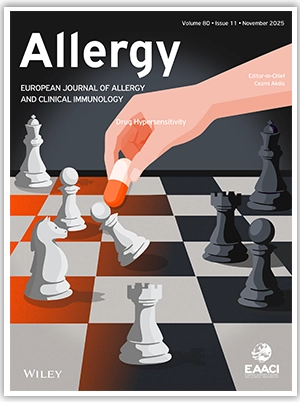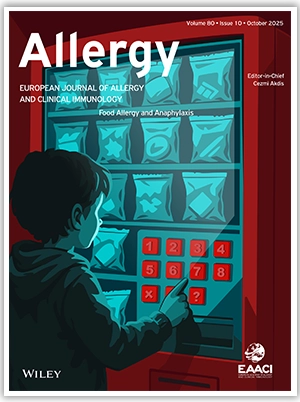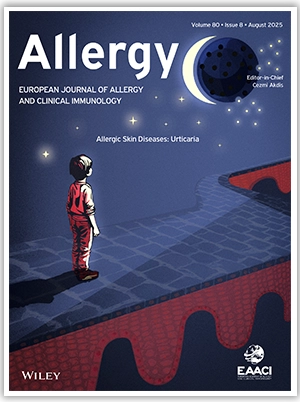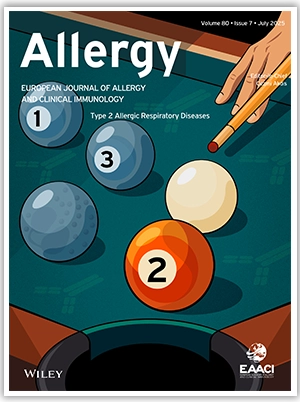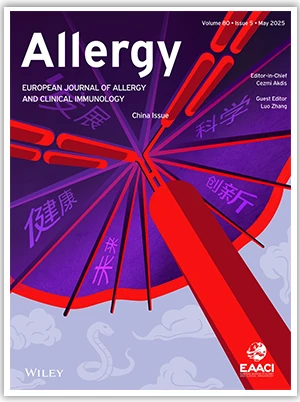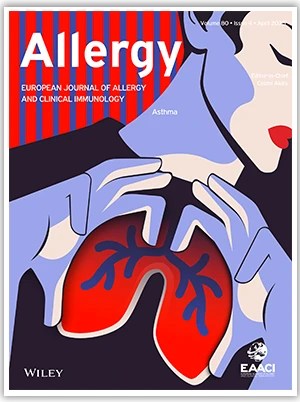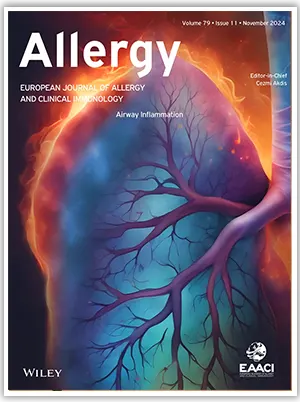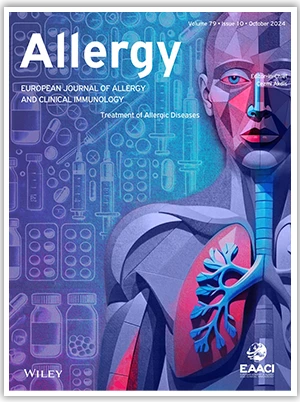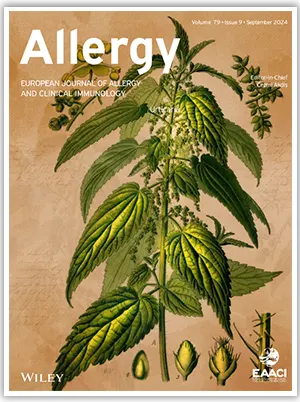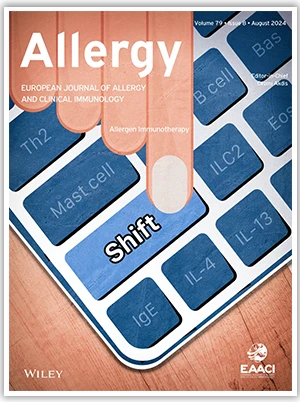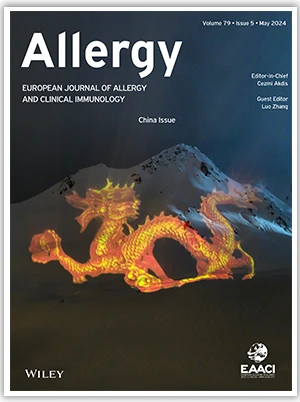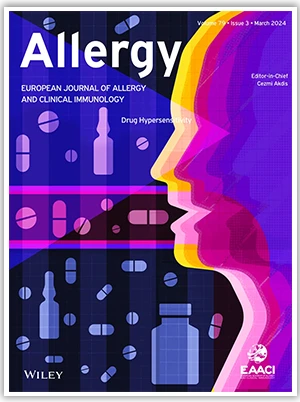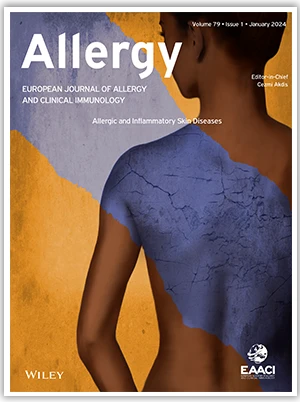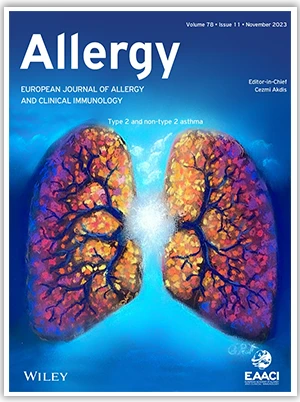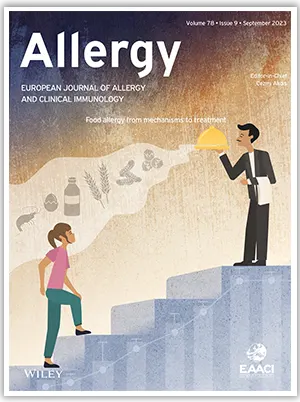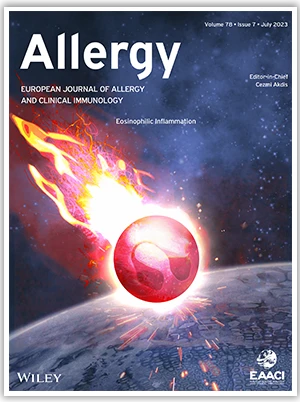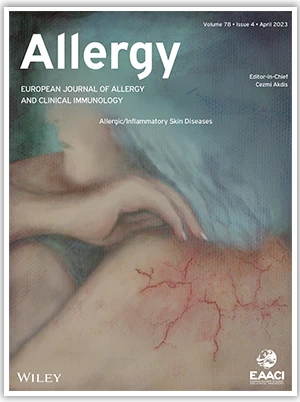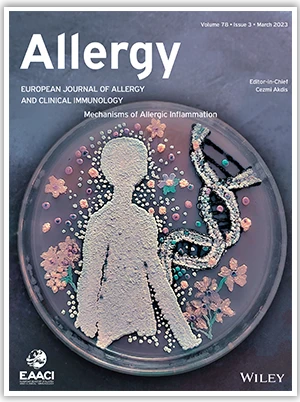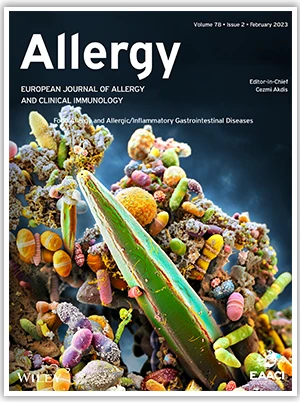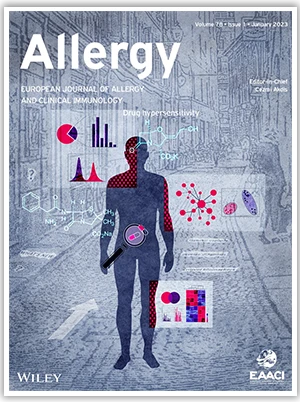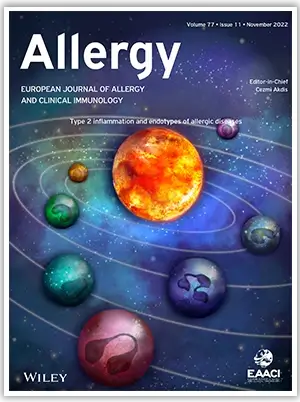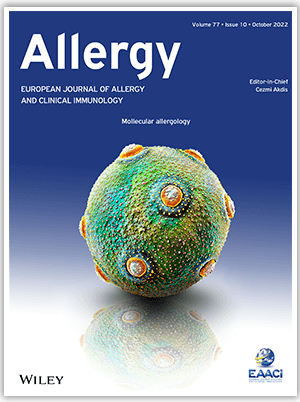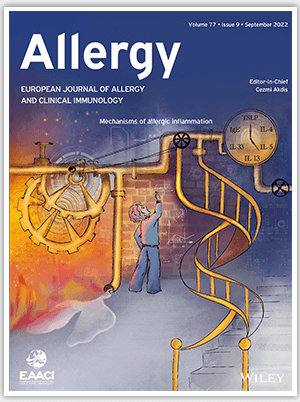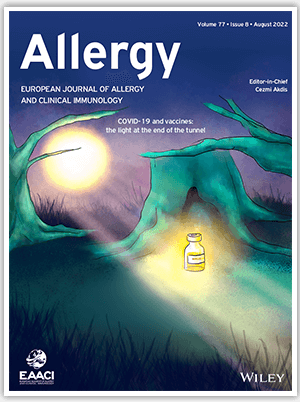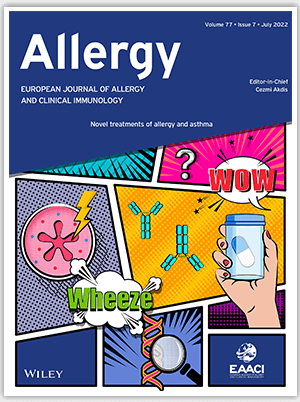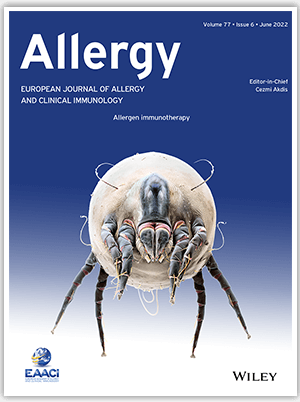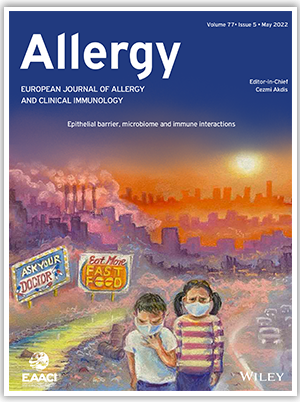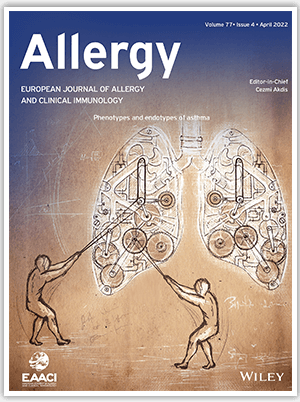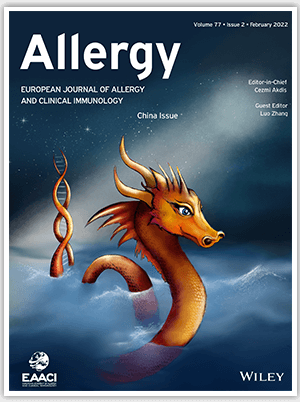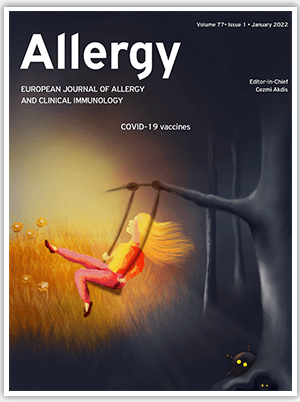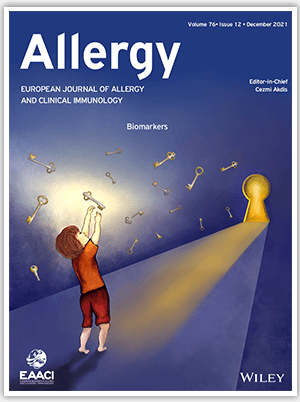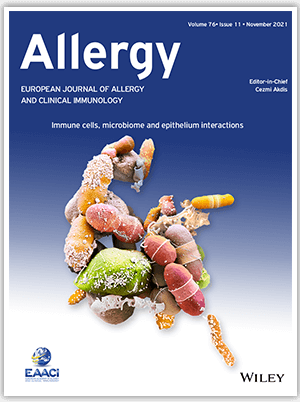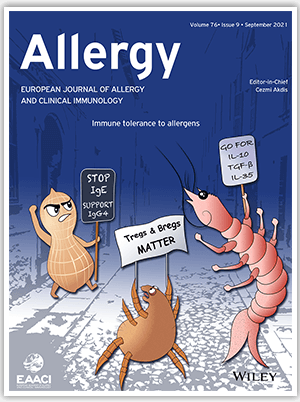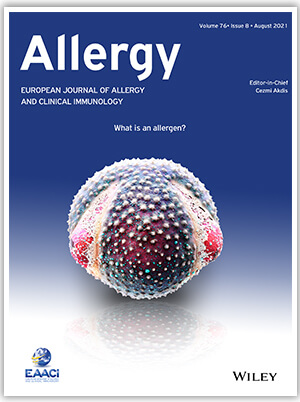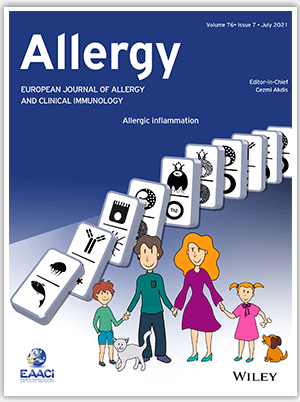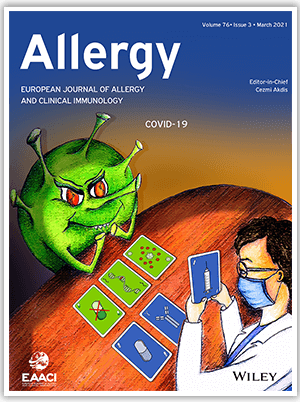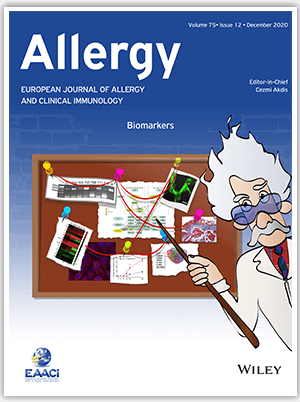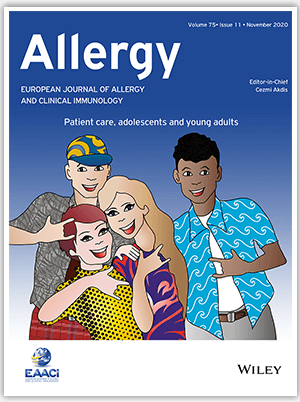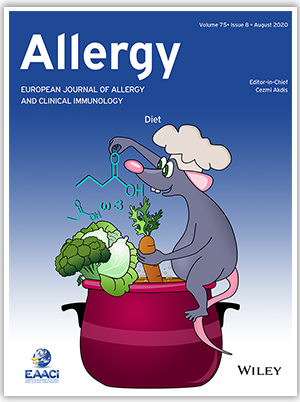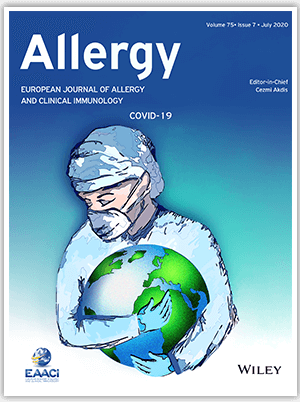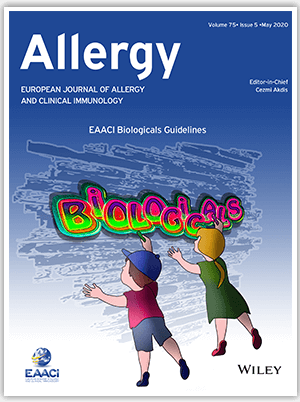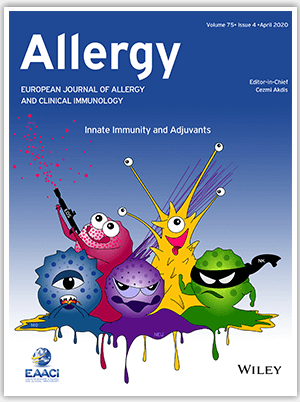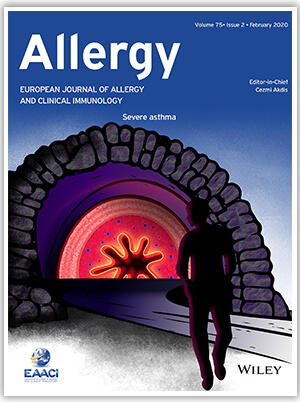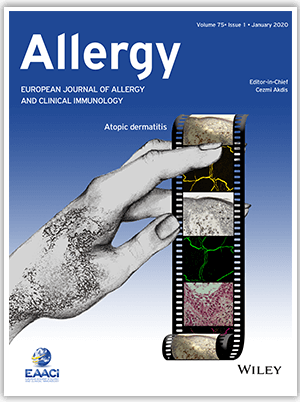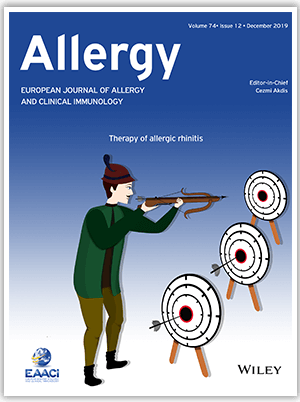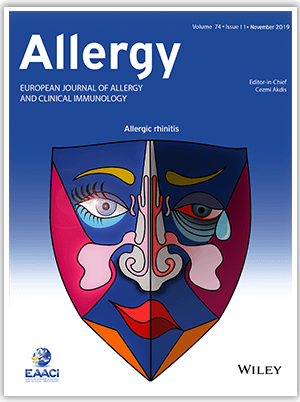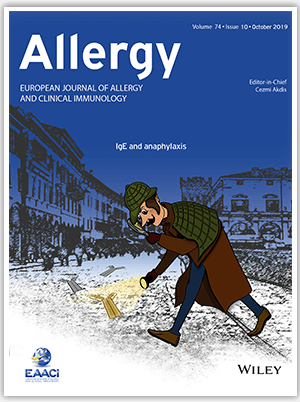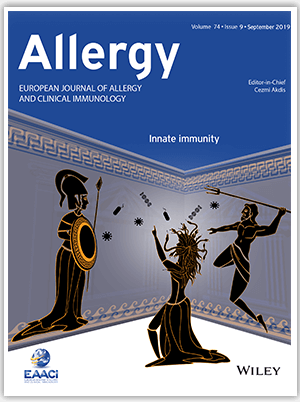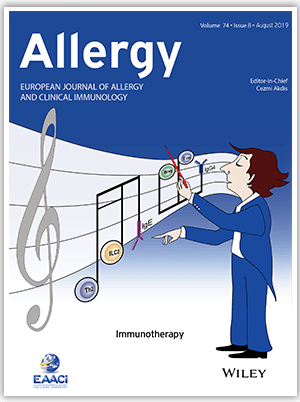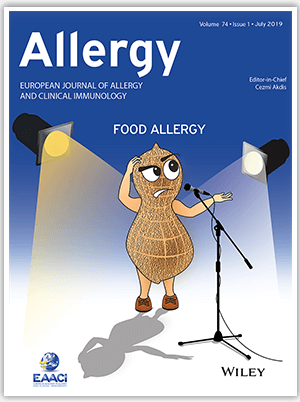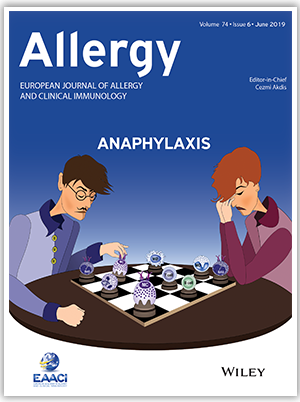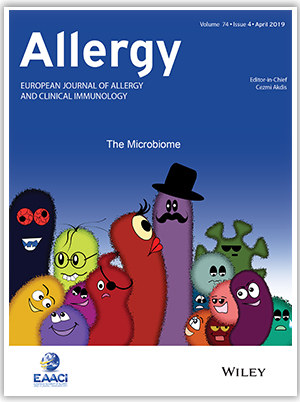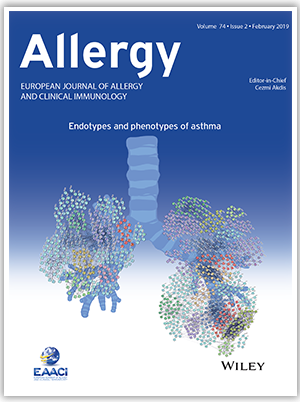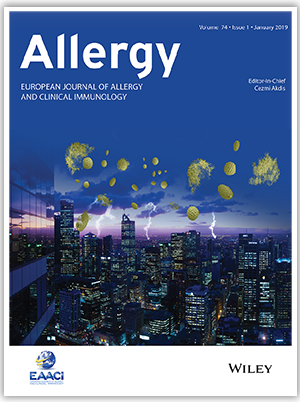Cover Gallery
November 2025 - Drug Hypersensitivity
Drug hypersensitivity reactions (DHRs) constitute a major concern in clinical practice, as they compromise patient safety and restrict the use of essential medications.
October 2025 - Food Allergy and Anaphylaxis
Food allergies represent a significant and escalating global health burden, with clinical manifestations ranging from mild reactions to severe, life-threatening anaphylaxis. Factors such as harmful environmental exposures, poor dietary choices, and gut microbiota dysregulation are increasingly recognized beyond genetic predisposition as contributors to the development of allergies and disease severity. In individuals with food allergies, processed food intake should be particularly avoided as it may contain traces of allergens and cell toxic additives. Dietary exposures can influence immune regulation, gut microbiota composition, and the risk of severe allergic events such as anaphylaxis. Potential approaches for the treatment and management of allergies under investigation include specific immunotherapy, biologics targeting key immune pathways, microbiome-modulating strategies, and dietary interventions.
September 2025 - From Molecular Mechanisms to Biological Treatments
Advances in molecular and cellullar biology and their interaction with the environment are providing profound insights into the molecular mechanisms and dysregulated immune responses underlying allergic diseases. This deeper understanding allows for the development of precisely tailored therapies that directly modulate these pathogenic processes, marking a crucial shift from symptomatic intervention to targeted biological therapies.
August 2025 - Allergic Skin Diseases: Urticaria
The skin is the body's largest immune organ, serving as a protective barrier that prevents water loss and blocks the entry of harmful substances. Disruption of this barrier by environmental pollutants, pathogens, or parasites leads to the release of epithelial-derived alarmins, which initiate type 2 immune responses. These responses are characterized by the activation and recruitment of inflammatory cells, including T lymphocytes, dendritic cells, and macrophages, contributing to the pathogenesis of allergic skin diseases. Among these, urticaria represents a prevalent and clinically heterogeneous condition, defined by the sudden onset of transient wheals, angioedema, or both. The underlying mechanism involves cutaneous mast cell degranulation, resulting in the release of histamine and other pro-inflammatory mediators that drive sensory nerve activation, vasodilation, increased vascular permeability, and immune cell infiltration.
July 2025 - Type 2 Allergic Respiratory Diseases
Type 2 allergic respiratory diseases are driven by a coordinated immune response that begins with epithelial cell activation and alarmin release, triggering innate lymphoid cells, dendritic cells, and macrophages, ultimately directing adaptive immune responses involving Th2 cells and IgE-producing B cells. Type 2 cytokines orchestrate the recruitment and activation of eosinophils, mast cells, and basophils, perpetuating inflammation and disrupting the epithelial barrier. Although biologic therapies targeting IL-4/IL-13, IL-5, and IgE pathways have demonstrated broad efficacy, the lack of response in some patients with severe disease highlights the need for more tailored, precision-based treatment approaches.
June 2025 - Asthma
Asthma is a chronic and complex disease defined by persistent inflammation of the airways, affecting over 350 million individuals globally and representing a major public health burden. Despite considerable advances in our knowledge of its pathophysiology and available treatments, asthma remains a heterogeneous disorder with varied underlying causes. Its complexity arises from the interaction of the immune system, environmental factors, tissue cells, epithelial barriers, microbiome and genetic susceptibility, underscoring the importance of identifying new biomarkers, therapeutic approaches, and diagnostic tools.
May 2025 - China Issue
Over the past decades, China has seen an exponential growth in its economy and scientific advances. This issue celebrates the scientific excellence and international collaborations with Chinese scholars. Blending Chinese tradition, symbolized by an oil-paper umbrella, with an antibody representing allergy, the cover image depicts the pillars of China’s contribution to advancements in the field of allergy: 科学 (science), 创新 (innovation), 健康 (health) and 发展 (development).
April 2025 - Asthma
Asthma is a complex chronic disease marked by persistent airway inflammation and remains a significant global health concern, affecting over 350 million people worldwide. Despite advancements in understanding its pathophysiology and treatment options, asthma remains a heterogeneous condition with diverse underlying mechanisms, requiring personalized approaches to management. The interplay of immune responses, environmental exposures, and genetic predisposition contributes to disease variability, making it crucial to explore novel biomarkers, therapeutic targets, and diagnostic tools.
March 2025 - Allergen Immunotherapy
Allergen immunotherapy (AIT) is a treatment that involves the gradual and controlled exposure to allergens to treat IgE-mediated allergic conditions. It remains the only disease-modifying therapy capable of inducing allergen tolerance and mitigating Th2-driven allergic inflammation. The process of achieving tolerance involves sustaining regulatory T and B cells, normalizing allergen-specific immune responses, shifting IgE production toward IgG, adjusting activation thresholds for mast cells and basophils, and modulating non-allergen-specific immune cells. As patients progress through AIT, their sensitivity to allergens diminishes, leading to reduced allergic inflammation, symptom relief, and an overall improvement in quality of life.
February 2025 - Mechanisms of allergic diseases
In-depth research on the elucidation of the molecular mechanisms of allergic diseases continues at full speed. Environmental exposures, coupled with genetic susceptibility, modulate these mechanisms, significantly influencing the onset and severity of allergic diseases.
January 2025 - Food Allergy
Food allergies are an increasing global health concern, presenting with symptoms ranging from mild reactions to severe, life-threatening anaphylaxis. The consumption of processed foods is linked to numerous health risks including cardiovascular diseases, type 2 diabetes, obesity and metabolic diseases, cancer, and many other chronic inflammatory diseases. Limiting the consumption of processed foods is crucial for supporting immune and gut health in individuals with food allergies.
December 2024 - Exposome, Epithelial Barriers and Microbiome
External and internal factors such as pollutants, allergens, pathogens, climate change, diet and lifestyle, collectively referred to as the 'exposome', can trigger the activation and opening of epithelial barriers, compromising their protective function and increasing exposure to harmful agents. As a result, disruptions in epithelial barrier integrity can contribute to changes in microbiome and activation of the immune system leading to the onset or exacerbation of various diseases, including allergies, asthma, and other chronic inflammatory conditions.
November 2024 - Airway Inflammation
Airway inflammation is a central feature of respiratory disorders, characterized by the infiltration of immune cells into the upper and lower respiratory mucosa. This inflammatory response leads to structural changes, including airway wall thickening, mucus overproduction, and epithelial barrier defects in the affected respiratory tissues. Consequently, these alterations result in persistent respiratory symptoms and diminished quality of life for affected individuals.
October 2024 - Treatment of Allergic Diseases
Allergic diseases are characterized by abnormal immune responses to ordinarily innocuous environmental substances, leading to inflammation and a variety of clinical symptoms. Treatment approaches have advanced significantly, incorporating various strategies to manage symptoms and target underlying immune mechanisms, including immunotherapy, pharmacotherapy, and innovative biological agents that target specific immune pathways.
September 2024 - Urticaria
Urticaria, a common and heterogeneous inflammatory skin disorder, derives its name from the Latin word "urtica," meaning nettle. This etymology reflects the striking resemblance between urticarial lesions and the stinging rash caused by contact with stinging nettles, especially the European stinging nettle, Urtica doica. The term 'urticaria' was first introduced into medical literature in 1769 by William Cullen. The disease presents as wheals, angioedema, or both, resulting from cutaneous mast cell degranulation of histamine and other inflammatory mediators, which cause sensory nerve activation, vasodilatation, plasma extravasation and cellular recruitment.
This issue is dedicated to Marcus Maurer in recognition of his groundbreaking contributions to the fields of dermatology and allergy, particularly for his work in advancing our understanding of the molecular mechanisms and treatment of urticaria.
Illustration of Urtica doica was obtained from the book ‘Flora von Deutschland, Österreich und der Schweiz’ 1885, Gera, Germany by Prof. Dr. Otto Wilhelm Thomé.
August 2024 - Allergen Immunotherapy
Allergen immunotherapy (AIT) is a therapeutic approach that involves the controlled delivery of allergens to treat IgE-mediated allergic disorders. As patients progress through AIT, a pivotal immunological shift occurs, steering towards a state of allergen tolerance. This AIT-driven transformation results in a gradual reduction in allergen hypersensitivity, ultimately leading to the alleviation of allergic symptoms.
July 2024 - The Exposome and EAACI Environment Guidelines
The exposome encompasses all exogenous and endogenous exposures humans experience throughout their lifespan, providing a holistic view of health and disease. Climate change modifies many environmental exposures, such as air quality and temperature, exacerbating health conditions and introducing new threats.
Cover artwork by Prof. Susan L. Prescott
June 2024 - Atopic Dermatitis
The skin is the largest immune organ, acting as a protective layer between the body and the environment. It restricts water loss and prevents the entering of harmful substances to deeper tissues. When environmental pollutants, parasites, and bacteria compromise the skin barrier, alarmins are produced, initiating type 2 immune responses. Microbial dysbiosis of the skin has been observed in atopic dermatitis patients, characterized by a loss of microbial diversity and an overabundance of pathogenic Staphylococcus aureus. This microbial imbalance stimulates the production of inflammatory cells, such as T cells, dendritic cells, and macrophages, contributing to disease severity, and perpetuating inflammation, itching, and further disruption of the skin barrier.
The cover image depicts the colony Staphylococcus aureus. Photo credit: © M Oeggerli 2007, supported by Pathology, Univ. Hosp. Basel and School of Life Sciences, FHNW, Muttenz.
May 2024 - China Issue
Celebrated worldwide, Chinese New Year, also known as Lunar New Year, marks the beginning of a new year, with 2024 being the Year of the Wood Dragon. The dragon, a revered symbol in Chinese culture, embodies success, wisdom, and strength, reflecting China's advancements in science and innovation. The dragon's legendary resilience and adaptability symbolize the spirit of innovation driving China's scientific achievements. This year, Chinese tradition was honored by Swiss light artist Gerry Hofstetter in his breathtaking projection of a majestic dragon on the clouds and snow-capped peaks of Davos.
Light artwork featured on the cover: Gerry Hofstetter
Photograph featured on the cover: Mike Kessler
April 2024 - Allergen immunotherapy
Allergen immunotherapy (AIT) is the monitored administration of allergens at increasing doses as a treatment for IgE-mediated allergic conditions. Currently, AIT is the only disease-modifying therapy that can achieve allergen tolerance and resolve Th2-driven allergic inflammation. The transition toward tolerogenic responses requires maintaining regulatory T cells and regulatory B cells, normalizing allergen-specific T cells and B cells, shifting IgE towards IgG production, adjusting activation thresholds for mast cells and basophils, and modulating non-allergen-specific immune cells. Over time, patients undergoing allergen immunotherapy experience decreased sensitivity to allergens, resulting in a significant decrease in allergic inflammation parameters, relief of symptoms and improved quality of life.
March 2024 - Drug hypersensitivity
Drug hypersensitivity reactions present a global health concern as they can limit treatment options and trigger life-threatening reactions. Its prevalence is anticipated to increase with the introduction of new medications, highlighting the need for a better understanding of its pathological mechanisms.
February 2024 - Food Allergy and Nutrition
Food allergies are a growing global health concern with symptoms ranging from mild to severe cases leading to anaphylaxis. Avoidance of foods containing the triggering allergen is typically recommended but may cause nutritional deficiencies if the patient is not following a personalized diet plan.
January 2024 - Allergic and Inflammatory Skin Diseases
The skin represents the body's largest immune organ and serves to protect against the external environment. It impedes water loss and prevents the entry of potentially harmful substances. When environmental pollutants compromise the integrity of the epithelial barrier, the production of alarmins triggers inflammatory responses. The activation and migration of inflammatory cells, including T cells, dendritic cells, and macrophages, contribute to the development of skin diseases. The persistent activation of these responses sustains the inflammatory cycle, causing inflammation, itching, and further disruption of the skin barrier.
December 2023 - IgE and its regulation in allergic disease
Immunoglobulin E (IgE)-mediated allergy is a Type I hypersensitivity caused by an overreactive immune response to innocuous agents. Binding of IgE to FcɛRI activates the release of histamine and other inflammatory mediators from mast cells and basophils upon encounter with an allergen, leading to the immediate adverse reactions observed in atopic diseases. As such, studies in the last two decades have focused on biologics targeting IgE antibodies and allergen-specific immunotherapy to regulate IgE production.
November 2023 - Type 2 and non-type 2 asthma
Asthma is one of the most common chronic non-communicable diseases across the globe. In recent decades, it has been recognized as a heterogeneous condition that can be categorized as either type 2 or non-type 2 asthma, depending on the presence or absence of type 2 inflammation.
Cover artwork by Prof. Susan L. Prescott
October 2023 - Allergic Rhinitis and Chronic Rhinosinusitis
Allergic rhinitis and chronic rhinosinusitis are common diseases affecting the upper respiratory tract. Allergic rhinitis results from T cell, B cell, dendritic cell, innate lymphoid cell, mast cell, epithelial cell and IgE-mediated responses to inhaled allergens and is frequently associated with asthma, atopic dermatitis and conjunctivitis. Chronic rhinosinusitis is recognized as a heterogeneous disease with a wide range of clinical features. Phenotypic classification depends on the presence or absence of nasal polyps and comorbidities. Additionally, endotype classification is established through the identification of molecular biomarkers or specific underlying mechanisms. Biological treatments are recommended for type 2-mediated chronic rhinosinusitis with nasal polyps.
September 2023 - Food allergy from mechanisms to treatment
Food allergies are a global health concern due to their rising prevalence and potentially life-threatening reactions. Currently, the primary approach to the management of food allergies revolves around a food-elimination diet. Oral immunotherapy and epicutaneous immunotherapy have been steadily growing as an alternative to food avoidance. A precision medicine-based approach, such as risk phenotyping will enable tailored treatment strategies for each patient. Collection of big data through world-wide networks, development of artificial intelligence algorithms and even more public education are needed. Packaged food ingredients, such as emulsifiers, anti-bacterials and anti-fungals should be carefully analysed for their epithelial barrier damaging and microinflammatory effects.
August 2023 - Atopic Dermatitis
The prevalence of atopic dermatitis has been on the rise, becoming a significant global health concern. This chronic inflammatory skin disorder affects individuals of all ages, with substantial impacts on their quality of life and general health care burden. Recognizing the multifactorial nature of atopic dermatitis becomes crucial in devising successful prevention methods and advancing therapeutic interventions.
July 2023 - Eosinophilic inflammation
Eosinophilic inflammation is a complex immunological process characterized by the infiltration of eosinophils into tissues. Eosinophils play a significant role in allergic diseases and parasitic infections. Persistent eosinophilic tissue infiltration can lead to chronic inflammation and tissue damage, which is observed in various disorders, including eosinophilic airway diseases, dermatoses, and gastrointestinal diseases.
June 2023 - China Issue
In recent decades, the government of China has allocated significant financial resources to research and development. It is now at the forefront of scientific research as evidenced by the increasing number of publications in top-tier journals. The COVID-19 pandemic marked a turning point for Chinese research, as their early findings contributed to the fight against the novel coronavirus. Thanks to the global collaborations towards this common cause, this year we have seen the lifting of COVID-19 measures and we are now living the new normal.
Cover design: Natalia Noszczyńska
May 2023 - Experimental Models for Allergy Research
Selecting an appropriate experimental model is essential in basic and translational research. The use of in vitro, in silico and in vivo models facilitates the study of the molecular mechanisms underlying immune responses, the characterization of allergens, and the role of genetic factors and the exposome. Although mouse models represent an important tool for studying disease mechanisms, they do not entirely mimic human physiology and so the therapeutic response does not always translate directly to humans. Organs-on-a-chip mimic the structural and functional characteristics of human tissues and have overcome some of the limitations imposed by in vivo models.
April 2023 - Allergic/Inflammatory Skin Diseases
The skin is the largest immune organ that serves as a protective layer between the body and the environment. Skin barrier restricts water loss and prevents the entry of external potentially harmful substances. Once the integrity of the barrier is compromised by environmental pollutants and parasites, the production of alarmins initiates type 2 immune responses. The activation and skin migration of inflammatory cells, such as T cells, dendritic cells and macrophages contribute to the pathogenesis of atopic dermatitis. Continued activation of these responses maintains the inflammatory cycle, leading to further inflammation, itch, and skin barrier disruption.
March 2023 - Mechanisms of Allergic Inflammation
Allergic inflammation results from cellular and humoral responses that activate the innate and adaptive immune system. Damage on epithelial barriers followed by colonization of opportunistic pathogens and an immune response development towards opportunistic pathogens and commensal bacteria is an essential part of mechanisms of allergic inflammation. These events trigger pathophysiological and structural changes affecting target tissues such as the airways, digestive tract and the skin. In the past several decades, research in the molecular and cellular underpinnings of allergic inflammation have significantly advanced our understanding of the underlying mechanisms, improving the diagnosis and treatment of allergic diseases.
This issue cover image features agar art by Dr. Ilvana Çaklovica Küçükkaya created by culturing different Candida species (Candida auris, Candida albicans, Candida tropicalis, Candida krusei, Candida glabrata) and Trichosporon spp.
February 2023 - Food Allergy and Allergic/Inflammatory Gastrointestinal Diseases
Gastrointestinal diseases encompass a broad spectrum of adverse, food antigen-driven and immune-mediated disorders. There are various mechanisms underlying different diseases; however, common aspects include epithelial barrier and microbiome impairment, loss of immune tolerance, and immune deviation. Numerous factors modulate disease mechanisms ranging from infections through dietary and multiple exposome-related factors.
This issue cover artwork features a colored scanning electron microscopy image of a healthy human gut microbiome with the world’s largest heterotrophic bacteria - Epulopiscium sp. in the central part of the image. Photo credit: © Martin Oeggerli / Micronaut 2015, supported by Pathology, Univ. Hosp. Basel, Swiss TPI (HP Marti), and School of Life Sciences, FHNW.
January 2023 - Drug hypersensitivity
Drug hypersensitivity is defined as an adverse reaction to a safe, therapeutic dose of a drug. Heterogenous clinical presentations and variability in the mechanisms underlying drug hypersensitivity pose a challenge for optimal diagnosis and treatment.
December 2022 - Changing directions in allergy research and patient care
The current diagnostic and therapeutic approaches are shifting to a more personalized patient care. We are beginning to understand how particularly the environmental exposure in addition to genetic traits impacts the course of disease and response to treatment. Bioinformatics and machine learning methods optimized for large data set integration and improved sampling methods facilitate the optimized intervention and treatment. Cover artwork by Prof. Susan L. Prescott
November 2022 - Th2 inflammation and endotypes of allergic diseases
Over 1.5 billion people are affected by allergic diseases worldwide and its prevalence is on the rise due to increased exposure to harmful substances from pollution, industrialization and modernized life-style and poor diet. As such, there is an urgent need to elucidate the complex mechanisms underlying the pathogenesis of allergic diseases and identify specific endotypes towards a precision and personalized approach to patient care.
October 2022 - Molecular allergology
An improved understanding of the molecular mechanisms underlying allergic disorders together with advances in tools for allergen characterization have facilitated an earlier diagnosis and monitoring of allergic diseases, further improving the 100 years old historical way towards patient-tailored disease management. The cover image depicts a colored scanning electron microscopy image of a Plantago pollen. Photo credit: © M Oeggerli / Micronaut 2020, supported by Pathology, Univ. Hosp. Basel, and Bio EM Lab, Biozentrum, Univ. Basel.
September - Mechanisms of allergic inflammation
In the last decades, research on the immune mechanisms underlying allergic inflammation has significantly advanced our understanding of allergic disorders. It is becoming increasingly clear that the pathology of allergic diseases is reflected by the long-term impact of allergic inflammation. The mechanisms underlying allergic inflammation involve a complex interplay between epithelial barriers, inflammatory cells and mediators, as well as numerous genetic and environmental factors.
August 2022 - COVID vaccines and new variants: the light at the end of the tunnel
The COVID-19 pandemic has presented new challenges to our healthcare system. It’s had a devastating impact on society, but thanks to the international scientific collaboration to develop vaccines and governmental policies to constrain the spread of the virus, we can now see the light at the end of the tunnel.
July 2022 - Novel treatments of allergy and asthma
The rise in the prevalence of allergic and inflammatory diseases caused by environmental changes due to urbanization, industrialization and modernization calls for novel treatments for such complex diseases. As such, there is an urgent need to further improve our understanding of the key pathophysiological mechanisms involved and identify novel molecular targets. In recent years, biologicals as inhibitors of unwanted inflammatory pathways and novel drug delivery systems are receiving attention. The discovery of novel biomarkers is paving the way for precision medicine as a personalized treatment approach.
June 2022 - Allergen immunotherapy
Allergen immunotherapy (AIT) is the monitored administration of allergen at incremental doses for the treatment of IgE-mediated allergic diseases. To date, AIT is still the only disease-modifying treatment that can potentially achieve allergen tolerance and suppress Th2-driven allergic inflammation. AIT acts by modulating the innate and adaptive immune responses. The shift towards tolerogenic responses requires maintaining regulatory T cell and regulatory B cells, normalizing allergen-specific T cells and B cells, regulating production of IgE and IgG, ameliorating activation thresholds for mast cells and basophils, and modulating non-allergen-specific immune cells.The cover image depicts a colored scanning electron micrograph of a house dust mite (Dermatophagoides farinae).
Photo credit: © M Oeggerli / Micronaut 2018, supported by Pathology, Univ. Hosp. Basel, and K N Goldie, Bio EM Lab, Biozentrum, Univ. Basel.
May 2022 - Epithelial barrier, microbiome and immune interactions
Environmental factors arising from industrialization, modernization and modern lifestyle damage the integrity of the epithelial barrier, predisposing an individual to allergic, autoimmune and chronic diseases. It is becoming increasingly evident that the epithelium, previously considered to simply function as a physical barrier is a crucial regulator of immune homeostasis. The epithelial cells interact with cytokines, microbes and their products and mediate the cross-talk with other immune cells in the mucosa. Cover artwork by Prof. Susan L. Prescott
April 2022 - Phenotypes and endotypes of asthma
The rapidly evolving concept of precision medicine involves accurate diagnosis and tailored treatment prompting our full understanding of the phenotypes and endotypes involved for the identification of disease biomarkers and the selection of appropriate therapeutic strategies. Asthma is a heterogenous disease with distinct phenotypes classified according to clinical categories (i.e., severity, age at onset), disease triggers (i.e., exercise, allergens, or irritants). These have important clinical implications, however, they do not necessary reflect the molecular and cellular mechanisms underlying the disease. As multiple physiopathological processes might be disguised as the same disease through common symptoms, delineating distinct mechanisms at the cellular and molecular levels, allow precise identification of asthma endotypes and are essential for improved asthma management.
March 2022 - Precision medicine
Precision medicine is a healthcare concept based on combined interpretation of the patient’s molecular (genomic, transcriptomic, metabolomic, proteomic, etc.), phenotypic and health information that empowers clinicians with data to prevent diseases and recommend an optimized therapy. In contrast to the traditional “one size fits all” approach, precision medicine considers numerous factors, including genetic and environmental factors that shape a person's response to a particular treatment. It is an innovative approach that is able to develop personalized or tailor-made interventions and improve health outcomes.
February 2022 - China Issue
The prevalence of allergic diseases worldwide continues to increase over time and poses significant challenges in terms of prevention, diagnosis, and treatment. The present issue of Allergy emphasizes the increasing scientific contributions by Chinese scholars in the field of allergic diseases. The cover image depicting a water dragon symbolizes the growth and impact of Chinese science.
January 2022 - COVID-19 vaccines
It has been over two years since the whole world started the fight against the novel coronavirus. The unprecedented global collaboration leading to the development of several highly effective vaccines gives us hope that the pandemic will be soon behind us. However, the emergence of the new virus variants keeps reminding us the remaining challenges around every corner and we are still oscillating between less and more optimistic scenarios. Although it is too early to switch back to the ‘life before-COVID’, we look at the bright side and believe in the power of science.
December 2021 - Biomarkers
Biomarkers are measurable indicators of normal or pathological processes. They are used as powerful tools to determine phenotype or endotype of a disease, predict clinical outcomes and monitor the response to treatment. In parallel with the development of novel therapeutic inventions, extensive research during the last decades has focused on the identification of biomarkers applicable in clinical practice.
November 2021 - Immune cells, microbiome and epithelium interactions
Response to various environmental challenges engages the interplay between immune cells, microbiome and epithelium. This extensive crosstalk encompasses multifold interactions in both homeostasis and disease state. Epithelial cells constitute a physical barrier against exogeneous allergens and are key regulators in maintaining immune homeostasis. Their interactions with microbes and microbial-derived products mediate the crosstalk between the epithelium and other cell types in the mucosa. The microbiome plays a fundamental role in immune training, development and function, shaping both innate and adaptive responses. In return, the immune system allows the colonization of commensal microorganisms, forming a strictly regulated mutualistic network. A better understanding of these highly sophisticated cellular and molecular networks is warranted for the development of novel therapeutics for allergic diseases. The cover image depicts the human microbiome. Micrograph taken and edited by © M Oeggerli / Micronaut 2017, supported by Pathology, Univ. Hosp. Basel, and School of Life Sciences, FHNW, Muttenz.
October 2021 - Skin Inflammation
The skin provides a protective barrier between the body and the environment, restricting water loss and preventing the entry of potentially harmful substances. In order to ensure an effective first line of defense against infections, the immune responses in the skin are undergoing strict regulation that involves extensive crosstalk between epithelial, stromal and immune cells, as well as microbial components. Dysregulation of these complex interactions underlie inflammatory skin disorders, such as atopic dermatitis and psoriasis.
September 2021 - Immune tolerance to allergens
Environmental changes are constantly challenging the immune system with a variety of potential stressing factors, including allergens, pathogens and toxins. To maintain homeostasis, the immune system identifies harmful agents and employs potent effector mechanisms to eliminate them, whilst avoiding an excessive self-damaging response. When these mechanisms are dysregulated, harmless substances are identified as threatening, resulting in a breakdown of immune tolerance that underlies allergic diseases such as allergic rhinitis, asthma, atopic dermatitis and food allergy. Currently, allergen-specific immunotherapy is the only approach to restoring immune tolerance in patients suffering from allergic diseases.
August 2021 - What is an allergen?
Allergens are defined as foreign proteins that induce an abnormal immunological Th2-type response that triggers an allergic reaction in predisposed individuals. This issue focuses on the characteristics of an allergen, including its structural features and function. The cover image depicts a colored scanning electron micrograph of an oak pollen, a common seasonal allergen. Micrograph taken and edited by Martin Oeggerli a.k.a. Micronaut. © M Oeggerli/ Micronaut 2016, supported by KN Goldie, Bio EM Lab, Biozentrum, Univ. Basel.
July 2021 - Allergic inflammation
Allergic inflammation is orchestrated by a complex interplay between various inflammatory cells. It plays a crucial role in diseases such as asthma, atopic dermatitis, allergic rhinitis and allergic conjunctivitis. This issue cover image depicts the allergic inflammation “domino effect”, the chain of consecutive reactions that eventually lead to a serious socio- economic burden affecting the lives of millions of people worldwide. In recent decades, significant progress has been made to prevent the “domino effect” at various stages. Available therapies attenuate the inflammation, but the cure is yet to be discovered.
June 2021 - COVID-19 vaccines
An unprecedented global colaboration between the life sciences industry, the research communities and healthcare systems has led to the development of several highly effective vaccines against the severe acute respiratory syndrome coronavirus 2 (SARS-CoV-2) in less than a year from the identification of the virus. Allergy dedicates this issue to this extraordinary accomplishment and expresses great appreciation to everyone involved in this historical success.
May 2021 - Food allergy and anaphylaxis
This issue cover image represents the Greek myth of Pandora, who was given a box with a special gift inside and was warned never to open it. Unfortunately, Pandora’s curiosity won and she opened the box, releasing all the diseases. Scared by her action, she closed the box immediately, slamming the hope inside. Here, we present Pandora opening the box again and releasing the hope for the successful prevention and treatment of food allergy.
April 2021 - Allergic skin diseases
This fascinating cover image depicts a colored scanning electron micrograph of Sarcoptes scabiei, a parasitic mite causing scabies, a common contagious skin disease. Skin diseases with an allergic background impose a significant burden on patients and on the healthcare system. The heterogeneity of these diseases and their co-morbidities poses challenges in their management. Micrograph taken and edited by Martin Oeggerli a.k.a. Micronaut. © M Oeggerli / Micronaut 2016, supported by KN Goldie, Bio EM Lab, Biozentrum, Univ. Basel.
March 2021 - COVID-19
Since the beginning of the pandemic, the whole world spared no effort to defeat COVID-19. We have learned the rules of the game, got used to social distancing, wearing masks and obeying restrictions, in hope to contain the spread of the virus. Although the virus has played many good cards – virulence, high-affinity binding to the receptors, mutations and resistance to drugs, scientists and doctors continue with theirs – vaccines, protective or therapeutic antibodies and antiviral drugs. The game is not over yet, but we believe that we have an ace in our sleeve. Allergy dedicates this issue to leading research focused on the clinical features, outcomes, diagnosis, immunology, and pathogenesis of COVID-19.
February 2021 - China Issue
The cover image depicts the Great Wall of China connected to a DNA helix directed towards the sky, inspired by the famous quote by Confucius - ‘Study the past if you would define the future’ (告往知来). The star constellations forming the letters 未来 (future) and 科学 (science) symbolize the growth in scientific achievements in allergy research during the past few years.
January 2021 - Biologicals
Biologicals have transformed the management and Systematic Reviews of severe disease phenotypes in asthma, atopic dermatis and chronic spontaneous urticaria. As a result, research towards novel biologicals for the treatment of chronic diseases is continuously increasing.
December 2020 - Biomarkers
The term ‘biomarkers’ refers to a broad range of biological makers that are indicators of normal biological processes, pathogenic processes, or pharmacological responses to therapeutic intervention. Large number of studies have been investigating the biomarkers of allergic diseases, including asthma, atopic dermatitis, allergic rhinitis, food allergy, urticaria and anaphylaxis. Various biomarkers have been developed by omics technologies, some of which lead to a better classification of distinct disease endotypes.
November 2020 - Patient care, adolescents and young adults
Adolescence is a challenging time for both patients and healthcare providers. Adolescent patients need additional support, while they experience the challenges associated with their age. They need specific training to learn the knowledge and skills required to confidently self-manage their allergies and/or asthma. Transitional care is a complex process, which should address the psychological, medical, educational and vocational needs of adolescent and young adult patients in the developmentally appropriate way.
October 2020 - IgE
The discovery of immunoglobulin E (IgE) in 1967 together with the identification of its central role in the pathogenesis of allergic inflammation was a breakthrough in the field of allergy and immunology. Understanding the mechanisms of allergic reactions and involvement of IgE has set the stage for the development of therapies directed at decreasing total IgE levels with anti-IgE monoclonal antibodies.
September 2020 - Climate Change
Since the beginning of the industrial revolution, the explosive process of urbanization dramatically affected environmental exposures. Air pollution has a significant impact on human health and contributes to the development of respiratory disease. Global climate change affects the distribution of allergens and increases the frequency and intensity of extreme climate events. This issue is dedicated to increase awareness of an impact of climate change on allergic diseases. Cover art by Prof. Susan L. Prescott conveys the message and illustrates the scientific content of this issue.
August 2020 - Diet
Recent changes in lifestyles, social interactions and diet in industrialized countries affect human microbiome and, as a consequence, increase the prevalence of allergies and asthma. Nutritional factors and their interaction with the gut microbiota influence immunological processes since an early age. The fermentation of fiber by commensal gut microbiota result in generation of short-chain fatty acids (SCFAs), including acetate, propionate and butyrate.
July 2020 - COVID-19
An outbreak of a new type of novel coronavirus disease (COVID-19) was first reported in Wuhan, China, in December 2019 and has subsequently spread rapidly to other areas across the globe. The disease is caused by human transmission of severe acute respiratory syndrome coronavirus 2 (SARS-CoV-2). Currently, over 150 countries have reported COVID-19 cases, and the situation has progressed to a pandemic associated with substantial morbidity and mortality. The cover image is dedicated to all healthcare professionals who have lost and are continuously risking their lives caring for the patients during the current pandemic. We owe a profound debt of gratitude to all healthcare workers on the front line against COVID-19.
June 2020 - Food Allergy
Over the past several decades, the prevalence of food allergy has continued to increase, affecting nowadays 6%-13% of the global population. Avoidance of allergenic foods and management of acute allergic reactions with antihistamines and epinephrine autoinjectors are the current standard of care. Allergen immunotherapy has been shown to increase the threshold of reactivity in the majority of food-allergic individuals.
May 2020 - EAACI Biologicals Guidelines
New biological therapies have been developed for severe asthma and may be applied depending on asthma phenotype and endotype. Omalizumab, a humanized monoclonal anti-IgE antibody; mepolizumab and reslizumab, anti-IL-5 monoclonal antibodies; benralizumab, a monoclonal antibody that binds to the α subunit of IL-5 receptor, dupilumab, a monoclonal antibody directed against the α subunit of the IL-4 receptor are currently available for patients. The European Academy of Allergy and Clinical Immunology (EAACI) has developed clinical practice guidelines for the use of biologicals in patients with severe asthma.
April 2020 - Innate Immunity and Adjuvants
Innate immune system, the first line of defense against invading pathogens, quickly recognizes microbes and foreign substances. Invading pathogens or other harmful substances trigger proinflammatory responses by activating innate immune cells, several of which are depicted on the cover image.
March 2020 - Biologicals and Allergen Immunotherapy
The development of biologicals, substances of a therapeutic potential, produced through a biological process often engaging biotechnological methods, remarkably advanced the management of many diseases, including cancer, autoimmunity, immune deficiencies, asthma and atopic dermatitis. Biologicals act through a specific blocking of certain molecular pathways involved in the disease pathogenesis. Although highly efficient, due to the costs, therapy with biologicals is often justified only in severe and chronic diseases. Another therapeutic option for patients with allergic asthma is allergen-specific immunotherapy.
February 2020 - Severe Asthma
Severe asthma, defined as inability to achieve or maintain optimal disease control despite use of high-dose medication and treatment of additional contributing factors, is a considerable challenge for patients and health care professionals, and a huge health burden. The evocative cover image in a surrealistic way depicts airway obstruction and emphasizes the severity of the disease.
January 2020 - Atopic Dermatitis
Atopic dermatitis is a chronic inflammatory disease affecting 5-10% of adults and up to 20% of children. It has a complex etiology arising from a combination of genetic, immune and external factors. The cover image depicts the compromised barrier function, which is considered an initial step in the development of atopic dermatitis. Although a genetically determined barrier disruption predisposes to atopic dermatitis, there are many other pathological mechanisms that lead to development of this disease.
December 2019 - Therapy of Allergic Rhinitis
Allergic rhinitis, a Th3-driven inflammatory disorder, whose prevalence is constantly increasing, has become a disease of civilization. Scientists and physicians around the world are joining forces in the search for the new treatment options to target allergic rhinitis. Hence, the cover image refers to the legend of the Swiss national hero, Wilhelm Tell, who accurately shot an apple off his son’s head. In like manner, the current therapeutic approaches are aimed to precisely target the mechanisms that contribute to disease development without causing any harm to patients.
November 2019 - Allergic Rhinitis
Allergic rhinitis is the most prevalent allergic disease characterized by sneezing, rhinorrhea, conjunctivitis, and nasal congestion. Due to these symptoms, patients suffering from allergic rhinitis experience sleep disruption, diminished activity and reduced productivity. The recent advances in the field of allergy pave the way towards precision medicine and opens novel approaches in order to improve the quality of life of patients with allergies. Hence, the cover image featuring a theatre mask shows two faces, allergic rhinitis on one side and a healthy and happy face on the other.
October 2019 - IgE and Anaphylaxis
The discovery of IgE, the critical player of type-l hypersensitivity, has opened the door for extensive understanding of the mechanisms of allergic responses. Despite the tremendous progress that has been made over the last 50 years, numerous unanswered questions about the function of IgE and IgE-mediated anaphylaxis remain. Therefore, the cover image features a detective on the trail of IgE, immersed in his search for the mechanisms, causes and novel approaches to treat or avoid anaphylaxis.
September 2019 - Innate Immunity
Latin proverb – “Si vis pacem, para bellum” that one can translate to “If you want peace, prepare for war” perfectly pictures the intense battle that the innate immune system takes on every day. Athena, Greek goddess of wisdom and war, represents the wisdom of the innate immune system that strategically defends against the incoming threat. Poseidon, god of the seas, is the first line of defense and furiously attacks foreign invaders. The innate immune system, like the shedding skin of the snakes on Medusa’s head, is constantly being replenished and rejuvenated.
August 2019 - Immunotherapy
Allergen immunotherapy (AIT) is the only causal treatment that can modify the course of allergic disease, preventing the development of asthma and new allergen sensitization. On the cover, AIT is illustrated as a conductor of the immune system orchestra, amplifying the pleasant sound of the regulatory components and suppressing the dissonance coming from allergen-induced inflammation, ensuring the harmony.
July 2019 - Food Allergy
The famous quote from Titus Lucretius Carus, a Roman philosopher-poet of the first century BC – “What is food to one, is to others bitter poison” – has become a food allergy motto. The number of people afflicted with food allergies appears to be steadily increasing. Oral tolerance is a normal physiologic response to ingested antigens. Breakdown of this tolerance results in sensitization to food allergens. The cover image presents a confused peanut under the spotlight, bringing attention to the growing problem of food allergy and raising the discussion of why food that has not caused harmful reactions for many centuries has become a current real threat.
June 2019 - Anaphylaxis
Anaphylaxis is a life-threatening systemic hypersensitivity reaction with a sudden onset characterized by bronchospasm and hypotension. Anaphylaxis can occur after exposure to insect venoms, drugs, certain foods, immunotherapy injections, and during the perioperative period.
May 2019 - EAACI Guidelines on HDM AIT
The European Academy of Allergy and Clinical Immunology (EAACI) has developed evidence-based recommendations for indications and contraindications to house dust mite (HDM) allergen immunotherapy (AIT) as add-on treatment for HDM-driven allergic asthma based on the Grading of Recommendations Assessment, Development and Evaluation (GRADE) approach. The authors have evaluated the body of evidence of the delivery route of HDM AIT for both adults and children. These guidelines are addressed to clinical allergists, respiratory physicians, pediatricians and other healthcare professionals.
April 2019 - The Microbiome
The term ‘microbiome’ refers to the multi-species microbial communities that exist in the human host. It is a highly dynamic environment, the composition and diversity of which varies across different locations in the body and is subject to change substantially over time. These variations are responsible for the existence of the unique habitats within and between individuals. The interplay between immune system and microbiota shapes the human health status. Immune maturation and activity depend on the colonization with a host-specific microbiota. Alterations in the establishment of the microbial communities have been associated with increased risk of allergy and asthma development, which may be linked to lifestyle changes in industrialized countries. Microbial metabolism and short-chain fatty acids (SCFAs) production strongly influence the growth of beneficial bacteria.
March 2019 - The Exposome
The exposome can be defined as exogenous and endogenous complex exposures that humans experience throughout their lifespan, providing a holistic view on human health and many diseases. The exposomic approach is particularly applicable to study chronic diseases, since it provides a risk profile instead of single predictors.
February 2019 - Endotypes and phenotypes of asthma
Asthma is a chronic respiratory disease with complex clinical and pathophysiological features. To elucidate the pathophysiology behind each phenotype and their underlying endotypes, Tan et al. developed in vivo models of allergen-induced airway inflammation representing eosinophilic, mixed and neutrophilic inflammatory phenotypes of asthma. Eosinophilic asthma was characterised by strong dysregulation of networks involved in cytoskeleton reorganisation, cell adhesion and junctions. Significantly changed genes in neutrophilic asthma model belonged to innate immunity signalling, inflammasome as well as Th17-related networks and pathways. Mixed asthma model shared many of the changed genes with neutrophilic phenotype. These data link cellular phenotypes with molecular endotypes and open a new window for more precision approaches to asthma patients. The cover graphics designed by Zuzanna Łukasik paraphrases the STRING (https://string-db.org) analysis of transcriptome data from the mouse models representing different endotypes and phenotypes of asthmatic airway inflammation.
January 2019 - Thunderstorm-triggered asthma attacks
Thunderstorm asthma was first described by medical doctors in the UK in 1983. This phenomenon is a sudden increase of acute bronchospasm due to a local thunderstorm during pollen season. Weather conditions such as wind and torrential rain combined with a high pollen count were suggested to trigger severe asthma among susceptible people. The largest and most catastrophic thunderstrom-triggered asthma epidemic occured on November 21st 2016 in Melbourne. In this issue, Hew et al. present an interview of 1435 patients affected by this event. The authors explored individual susceptibility and summarized compunding risk factors for hospital admission. An editorial written by D’Amato describes recent thunderstorm asthma events and their etiopathogenetic aspects.
Acta Allergolica
Allergy was founded by Ernst B. Salén as Acta Allergologica and was first published by Einer Munksgard in 1948. Salén was also the original editor-in-chief, however Egon Bruun also helped in the early years. Other editors-in-chief have been Gunnar Bendixen (1970–1992), Gunnar S. Johansson (1993–2002), Jean Bousquet (2003–2009), Thomas Bieber and Hans-Uwe Simon (2010–2017), and the current editor-in-chief Cezmi Akdis (March 2018–present).

